Resources
The Use of 316 Stainless Steel Instrument Tube Fittings on 6Mo Tube
Submitted by Graham Johnson, Product Manager || Parker
Introduction
Solutions for the Safe Connection of Instrumentation Tubing in Corrosive Environments
Increasingly, process control instrumentation solutions are being applied in ever more hostile environments. As a result, there has been a corresponding increase in the reported incidence of external corrosion to 316 stainless steel instrumentation tubing systems.Most of the investigations so far focus on pitting and crevice corrosion on 316 tubing close to tube clamps or surface contamination on the outside of the tubing such a weld splatter.
As a result of these investigations many end users are now selecting 6MO tubing to replace 316 for their offshore corrosive environments to extend the service life of equipment and to increase the safety.
There are many engineers now asking the question “If I replace my 316 tube material with 6MO, as this is where I am seeing the corrosion issues, then what material should I use for tube fittings and valves?"
This white paper has been written to help users make well-judged decisions on the right material selection for their particular application.
Material Selection
There are numerous factors involved in selecting the appropriate material for a specific application. To help users make an informed decision we have highlighted a number of these in appendix 1 and also provide guidelines to consider in appendix 3.
Cost
On each project the cost implications are a significant factor that should be considered. How can you calculate this cost? See appendix 6 for further elements to help you decide.
Corrosion
Many end users are moving from 316 stainless steel to 6MO material for their small-bore tubing applications to combat corrosion issues experienced in their current applications. The most common reasons for this change are due to existing facilities observing the types of corrosion explained in appendix 4.
Once this material selection has been made (change from 316 to 6MO) it is also important to ensure that ALL materials being used in the application meet the corrosion resistance expectations. The major methods for this verification are found in appendix 5.
Safety
The safety of personnel and the integrity of plant and equipment is the most important decision when making a selection on the most appropriate material. Balancing cost and safety decisions is one that requires careful consideration. See appendix 6 for further advice.
Decision
If after reviewing all of the above, the end user elects to use a combination of 6MO tube with 316 Stainless steel tube fittings, then Parker can confirm that both A-LOK® and CPI™ fittings will provide excellent mechanical performance on 6MO tube in accordance with appendix 2.
Statement
The use of 316 A-LOK® and CPI™ Tube fittings on 6MO Tube
As the renowned expert in the field, Parker has often been called upon to comment about or provide satisfactory solutions to this problem.One such solution, still by far the most satisfactory in all respects, with the lowest lifetime cost, highest performance and lowest risk, is the specification of 6MO tubing and tube fittings as a minimum.
As the pre-eminent supplier of this solution across our industry, Parker will fully warrant, without exception, the installation of A-LOK® and CPI™ tube fittings with their 6MO tubing in applications where this has been determined to be the most suitable material, providing the installation has been made by competent personnel fully in conformance to Parker instructions and guidelines.
Where 6MO tubing has been selected as the most appropriate corrosion solution, Parker strongly recommends that all fittings and valves should also be made from 6MO material. (See appendix 1 - Factors to be considered when making a material selection).
At the same time, Parker recognizes the challenge for all users, owners and operators alike, to recognize value and achieve more with less.
With this mind, we have carefully considered and tested the use of our 316 stainless steel tube fittings on Parker specified 6MO tube. As a direct result from more than 50 years of continuous development, our advanced manufacturing technologies, the expert specification and use of materials combined with our unique Suparcase™ surface treatment of ferrules, we can confirm satisfactory mechanical performance through excellent tube grip and an effective gas tight leak proof seal with our 316 stainless steel tube fittings on 6MO tubing (See appendix 2 – Tube selection guide when combining 316 Fittings onto 6MO tube).
This confirmation is within our published parameters and installation guidelines. Of course, these tests and this statement cannot take account of material compatibility (this important factor being a matter for selection by the user or system designer) and cannot simulate or provide validation for any specific application (See appendix 3 – Material Selection and appendix 4 – Examples of Corrosion).
Our tests were performed, purely to support the potential use of this product combination according to a specific set of published product pressure and temperature ratings under laboratory conditions.
The results of these tests, translated into the attached tube and fitting combination chart, should not be considered valid outside of those ratings or stated conditions. Parker will warrant the mechanical performance of this combination within these conditions when utilized on tubing meeting Parker specifications, within the context of this statement and subject to the correct and proper installation by competent personnel. No other warranty/guarantee is expressed or implied.
Final material selection should be subject to rigorous performance testing to ensure that both the mechanical and corrosion requirements are met (see appendix 5 – Corrosion testing – how to ensure top performing materials).
Finally, and most importantly, care should be taken to ensure the highest level of safety and integrity of any plant and equipment for the protection of both personnel and the environment (see appendix 6 – Safety and Integrity).
Clearly all projects need to consider initial outlay costs and balance these with the long term cost of ownership (see appendix 7 – Cost of Ownership)
It is the system designer or user responsibility to ensure the selected material and products are suitable for the intended application.
Please ensure you read the following appendices for useful information and guidelines:
- Appendix 1 – Factors to be considered when making a material selection
- Appendix 2 – Tube selection guide when combining 316 fittings onto 6MO tube
- Appendix 3 – Material selection
- Appendix 4 – Examples of corrosion
- Appendix 5 – Corrosion testing – How to ensure top performing materials
- Appendix 6 – Safety and integrity
- Appendix 7 – Cost of ownership
Appendix 1
Factors to be considered when making a material selection
- Critical nature of the system
- Media contained within the system (including pressure & temperature)
- Environmental influences (including temperature)
- Historical experiences
- Advice from experts
- Rate of corrosion
- Frequency of planned material change out
- Cost of product
- Installation costs
- Downtime costs when changing out product (i.e. loss of production)
- Inventory costs
- Product quality
- Company standards
- And of course, system SAFETY & INTEGRITY
Appendix 2
Tube selection guide when combining 316 fittings onto 6MO tube
These pressures are based on calculations in accordance with ANSI B31.1 & B31.3 with a 4:1 factor of safety on the allowable stress in the material. Other manufacturers may use alternative methods for determining tube pressure ratings such as using actual test data, this does not represent the worst case scenario in material mechanical properties.The tube and fitting combinations detailed below and the stated working pressure ratings, are supported by testing under laboratory conditions to prove the mechanical integrity of the combinations only. No warranty is expressed or implied with respect to suitability of the combination in specific applications. For tube sizes and wall thicknesses not in these charts, please consult the factory.
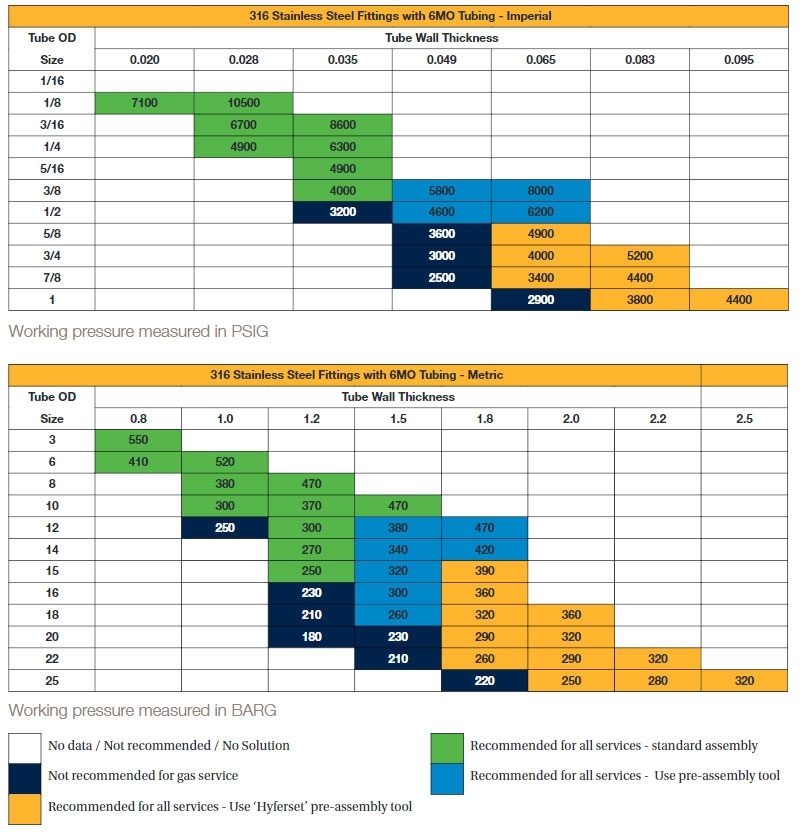
Parker Tubing Specification
High quality, fully annealed, Super Austenitic stainless steel conforming to ASTM A269/A213 Grade UNS S31254. Recommended hardness 80 HRb. Maximum permissible hardness 90 HRb. Parker recommends, that for higher hardness the use of pre-assembly or Hyferset tooling should be considered. Working pressure measured in PSIGWorking pressure measured in BARG
For tube sizes and wall thicknesses not in these charts, please consult the factory.
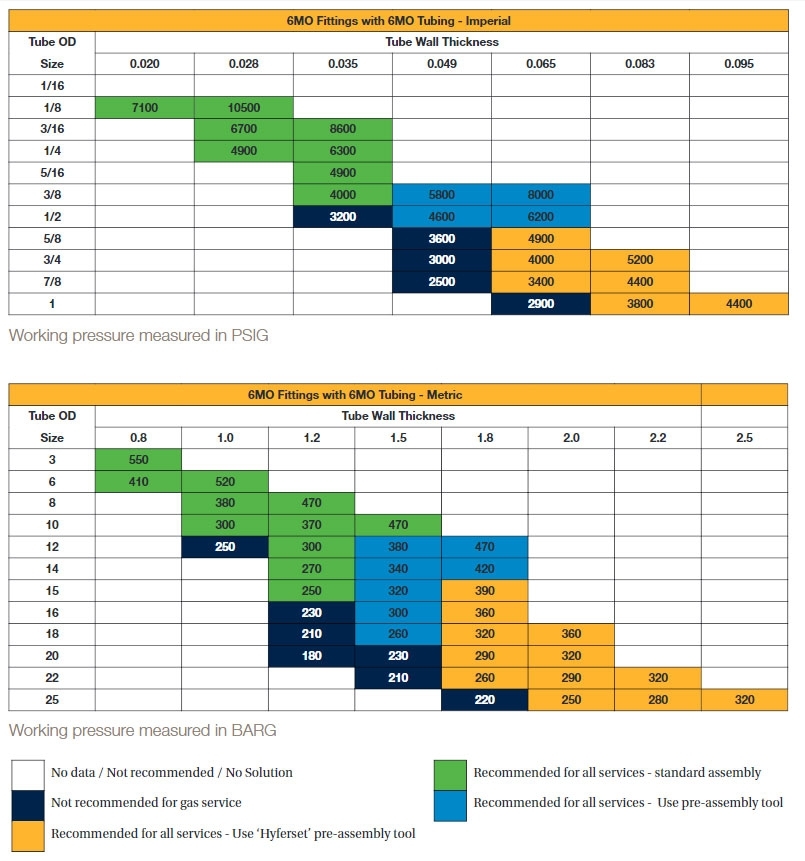
As part of our commitment to ensuring that all users of our A-LOK®, CPI™ and Autoclave fittings we offer a comprehensive, certified training program called Small Bore Expert (SBEx). Please contact Valin for more information.
Appendix 3
Material Selection
Due to the complex nature of material compatibility and environmental corrosion conditions it is essential that the owner / operator of a facility makes material selection decisions based on the best possible information available to them.This typically involves taking advice from experts in the field of corrosion. The final decision on material selection will be based on a number of key factors which include:
- Safety
- Life expectancy of equipment
- Process and environmental conditions
- Cost
- The design process should investigate the most appropriate material for a particular small bore tubing installation and use the latest specifications.
- The component parts selected should be materially compatible and be suited to the range of design applications
- This selection should be in accordance with operators’ material requirements for the project
Secondly, these guidelines go into material selection in much more detail, however, a very brief summary can be found below:
- Material selection should be carried out by a qualified metallurgist
- Consideration should be made for all possible types of corrosion
- Compatibility with internal fluids
- Chemical attack
- H2S
- HIC
- Mercury
- External / Environmental impact
- Sea water
- Temperature
- SCC
- Pitting
- Crevice
- Microbial
- Galvanic
- Compatibility with internal fluids
- Design life / life cycle requirements
- Associated process piping standards
Thirdly, these guidelines also give some basic material selection advice for tubing and fitting combinations as follows:
- 316 / 316L Tubing use 316 fittings
- 6MO (UNS S31254) Tubing use 6MO fittings
It should be noted that many corrosion issues such as pitting, Stress corrosion cracking and crevice corrosion are identified on tubing before it is seen on the fittings and valves. This is primarily due to the fact the tubing has a much bigger surface area exposed to the corrosive atmosphere and most tubing needs to be clamped to secure it in place and as a result shows crevice corrosion in those specific areas under the clamps.
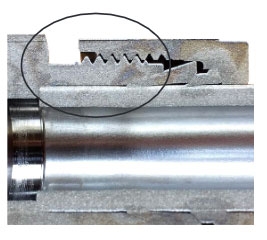
Some users state that they are happy to use 316 tube fittings on 6MO tube as they claim that the fittings have smaller surface area and that they have a greater wall thickness than the tube. The photograph to the right shows that when using thicker wall tubing results in a very close relation of tube wall thickness and the fitting component dimensions. Increased wall thickness does not equal increased corrosion resistance.
Appendix 4
Over the last 50 years Parker has witnessed a large number of corrosion challenges experienced by our customers in a wide variety of saliferous (sea water) environments, some examples of these are shown below.Pitting Corrosion
This is an extremely localized corrosion that leads to the creation of small holes in the material. Once pitting corrosion occurs, it can quickly spread into the material, corroding it entirely. Pitting is often the most destructive form of corrosion and the most difficult to detect since the pits that cause the initial attack are often very small yet corrode deeply.
Pitting corrosion typically occurs when there are points of weakness in the passive layer. Pitting is affected most by acids, chlorides and high temperature. Chloride is particularly damaging to the protective passive layer of a metal, so pitting can initiate at oxide breaks.
Critical pitting temperature of 316 / 316L stainless steel is in the range of 0°C to 30°C. For 6MO material this range is significantly higher 70°C to 90°C
Figures 1 and 2 show pitting on 316 / 316L tube. This type of corrosion can also occur on tube fittings made from 316, see picture below, failures like this can have catastrophic effects on personnel, plant and equipment.
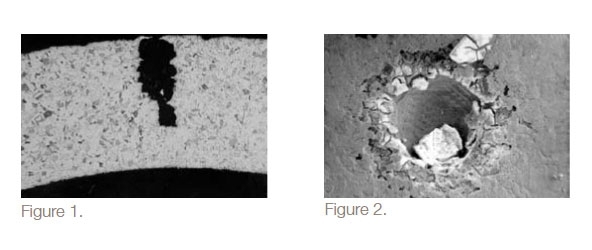
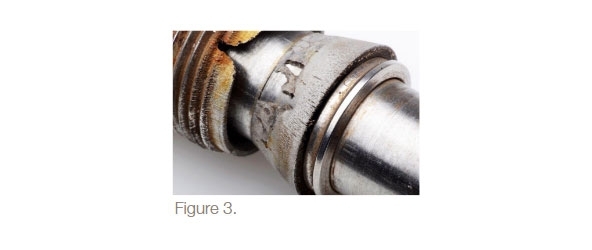
This occurs when there is tensile stress in combination with a corrosive environment.

It is only the combination of stress and corrosive media which causes it to occur – both factors must be present for SCC to take place. SCC often remains undetected as the surface of the parts in tensile stress look the same as all other parts around them.
Most of the surface appears unaffected, except for a few fine cracks – metals often remain bright and shiny – causing SCC to go undetected until catastrophic, unexpected, failures occur.
Crevice Corrosion
Crevice corrosion is an intense localized corrosion, which occurs within crevices or gaps between two joining services.
It can occur in the crevice or gap between two metals or a metal and non- metallic material.
Outside this area, the materials may be completely resistant to the corrosive environment, but when the corrosive solution becomes trapped or stagnant in this gap, chemical changes can occur in the solution causing the micro environment to be very corrosive. See figure 4 and 5.

Typical sites for crevice corrosion are:
- Under clamps / nuts / Washers
- Joints
- Under insulation
- Surface defects including weld splatter
Critical crevice temperature for 316 / 316L can be as low as 0°C. For 6MO this temperature rises to over 35°C.
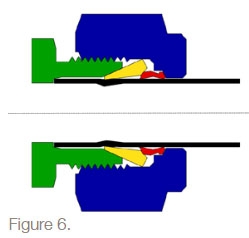
If 6MO tube has been selected to help combat crevice corrosion, then serious consideration should also be made with the tube fittings and valves being used in the same system.
Appendix 5
Corrosion Testing – How to Ensure Top Performing Materials
In order to ensure that the integrity of the materials you are using in your facility Parker recommend that you ensure that appropriate material verification testing is carried out to ensure that all elements of the small bore tubing assembly meet requirements and performance expectations.There are many international standards for corrosion testing, some are mentioned below, we recommend that when selecting 6MO tubing, fittings and valves that all pressure retaining parts should be tested in accordance with these standards to ensure appropriate system performance:
- ASTM B117 – Salt spray test
- ASTM G48 – Pitting and Crevice corrosion
Many manufacturers of twin ferrule fittings claim their material performs well in these tests, but typically only the body and nut are tested. A key component that ensures a grip on the tube at high pressure is the back ferrule. End users should satisfy themselves that they are using suitable materials for ALL components of the tube fitting.
Parker recognizes the need to use the highest possible levels of material quality. As such, all A-LOK® and CPI™ tube fittings made from 6MO fully comply with the material requirements as set out in the NORSOK M650 standards.
Appendix 6
Safety and Integrity
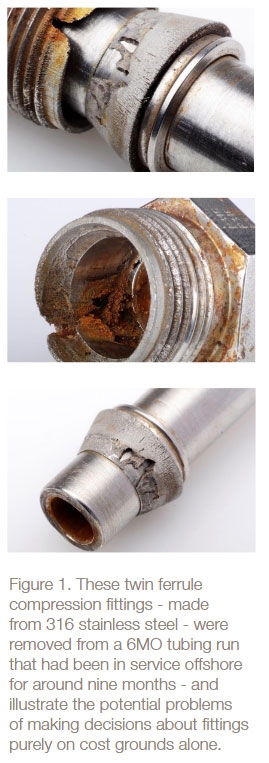
Parker make and supply an extensive range of fittings, valves and tubing in a wide variety of materials for use in a vast array of applications. Material selection plays an important part of plant safety and integrity.
It is the responsibility of the User, plant designer or plant operator to ensure proper component and material selection to ensure the safety of all personnel either inside or in close proximity to the plant. Consider the fittings shown in Figure 1.
These twin ferrule compression fittings - made from 316 - were removed from a 6MO super austenitic stainless steel tubing run that had been in service offshore for around nine months.
When the tubing run was assembled, the fittings gripped the tube correctly, and provided a good mechanical seal that was capable of handling the normal maximum pressures that are expected from a twin ferrule fitting.
However, in this case the media, environmental conditions and process temperatures were such that they provided an avenue for corrosion.
316 stainless steel typically has a PREN number of around 23, while 6MO has one of 42.
The critical pitting temperature for 316 stainless steel is only 20°C, whereas for 6MO it’s around 75°C. And critical crevice temperature for 316 stainless steel is close to 0°C, while for 6MO it’s around 38°C. These values provide a quick guide for material selection.
In the case of tubing assemblies that intermix 6MO and 316, although it is possible that some applications will be OK, you can see from the PREN numbers that the operating conditions of many applications - especially in offshore conditions where 6MO is widely used - will quickly lead to a corrosion problem.
Some fitting vendors point out that 6MO tubing and 316 fittings can be used together and create a reliable seal.
The initial outlay of a 6MO tube / 316 tube fitting selection may well result in a lower installation cost. However, we advise that such intermixing should only be considered with the benefit of a thorough analysis of the application.
The safer approach is always to use compatible tube fitting and tubing materials. We ask the question “Is it worth saving, say, 50% on the purchase cost of a fitting if you then must replace it every year?”
More importantly if a 316 fitting fails as a result of corrosion the cost impact of injury to personnel and other plant and equipment will far outweigh the initial saving made.
Appendix 7
Cost of Ownership
In every major project, there is always a conflict between keeping the initial purchase cost of equipment as low as possible and ensuring that the long-term cost of the entire plant is kept to a minimum.In this white paper, where the decision has been made to use 6MO tube for the Small Bore Tubing system, we compare below the initial spend on an all 6MO solutions vs using 316 fittings 6MO tube.
If 316 fittings last one third that of 6MO this means that two full fitting change outs will be required on the 316 system compared to zero change out on an all 6MO system.
- When a 316 fitting needs to be replaced then a large percentage of the tube will also need to be replaced
- Time to replace one fitting could be around 5 minutes (probably longer)
- Labor rates for offshore facilities are significant
- Parker estimate the cost of ownership of a 316 fitting / 6MO tube combination is at least 40% more than that of an all 6MO system - see table 1
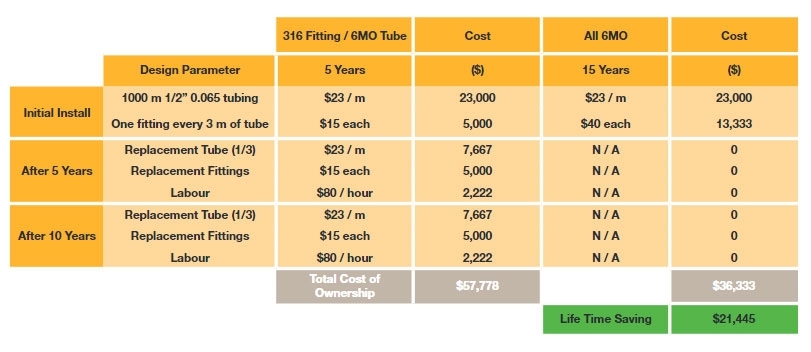
A lesson for me is that I need to involve you earlier in the program.
You were tireless in your support and it will not be forgotten!
